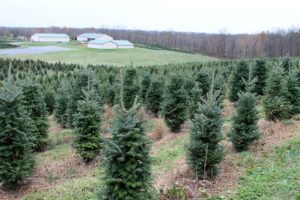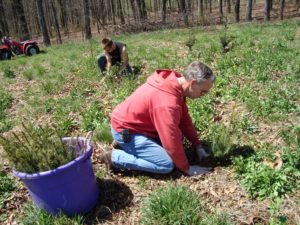Christmas Trees: Real or Fake?
November 29th, 2016
I know it’s tempting… those artificial or “permanent” Christmas trees are less work and look a lot nicer these days than the original ones, which were modeled (I’m serious) after toilet brushes.
Many of these trees come with lights already strung. You just fold out the branches, hang a few ornaments, and you’re good to go.
No wonder so many people have gone this route instead of the old-fashioned tradition of decorating a cut real tree – or better yet, going out to a tree farm and cutting your own.
That’s what we always did when our kids were little. Picking out, cutting down, and decorating the Christmas tree wasn’t just one more chore on the December to-do list. It was a family event, and frankly, one I miss now that the kids are grown and gone.
Bringing the box down from the attic just doesn’t have the same appeal to me.
But beyond the sentimentality, there are plenty of other reasons why I come down on the “real” side of the “real vs. fake” debate.
One concern I hear about going real is that it’s environmentally insensitive to cut down evergreen trees. “Aren’t you killing a living thing in the name of decoration?” the thought goes.
Yes, you’re cutting down and therefore killing a live tree, but the truth is, that tree wouldn’t have been there in the first place if there weren’t a demand for cut Christmas trees.
Christmas trees are grown as crops. They’re planted by tree farmers – to the tune of 40 million new ones per year – specifically because people want them for holiday use.
Without that demand, those 40 million Douglas firs, Fraser firs, Scotch pine and blue spruce wouldn’t have been planted.
Except for permit-only cuts in some national forests for fire-break creation, hardly anyone is going out into the woods to cut down a wild evergreen.
It’s a little like saying it’s environmentally unfriendly to eat corn because corn plants are killed in the process.
I’ve talked to Penn State horticulture professor and Christmas-tree expert Dr. Ricky Bates about this, which he calls a “silly debate” that just doesn’t seem to go away.
He points out that the Christmas trees currently growing on U.S. tree farms “provide the daily oxygen requirements for millions of people.” They also reduce soil erosion, create habitat for wildlife and sequester carbon, he adds.
An acre of evergreens produces enough oxygen for 18 people every day, and each tree absorbs a ton of carbon dioxide in its lifetime, according to Earth911, a national environmental-services company.
When this year’s trees are cut, tree farmers replant the fields with new ones.
If everyone switched to fake trees, those farmers either would have to switch to some other crop or go out of business. Or maybe more likely, sell the land for another housing development or strip mall.
These days, most cut trees are recycled into mulch after Christmas. Mine never even leaves my property. I use cut branches to insulate rose bushes in January and February before chipping them into my own mulch in spring.
True, pesticides and gas-burning equipment are used in growing and harvesting trees, so it’s not a zero-impact operation. But on the whole, Christmas-tree-growing is far more of an environmental plus than a negative.
Going the artificial route may sound like you’re “saving a tree,” but you’re instead buying a petroleum-based product (usually polyvinyl chloride) that’s made in a factory – most often in China – and then shipped thousands of miles to stores. After a typical lifespan of 6 to 9 years, artificial trees end up in landfills.
Besides the environmental edge, real trees offer the benefit of buying local.
A majority of the cut trees sold in area stores and stands were grown in Pennsylvania by Pennsylvania farmers. And Pennsylvania is one of the leading Christmas-tree producers in the nation, usually ranking around second in the number of Christmas-tree farms and fourth in the number of Christmas trees cut each year, according to the Harrisburg-based Pennsylvania Christmas Tree Growers Association.
Nationwide, it’s a $1 billion annual industry that involves an estimated 100,000 people, ranging from farmers to retailers to Scouts on the corner lot.
Personally, I’d rather support that than a foreign-made plastic product from a box store.









